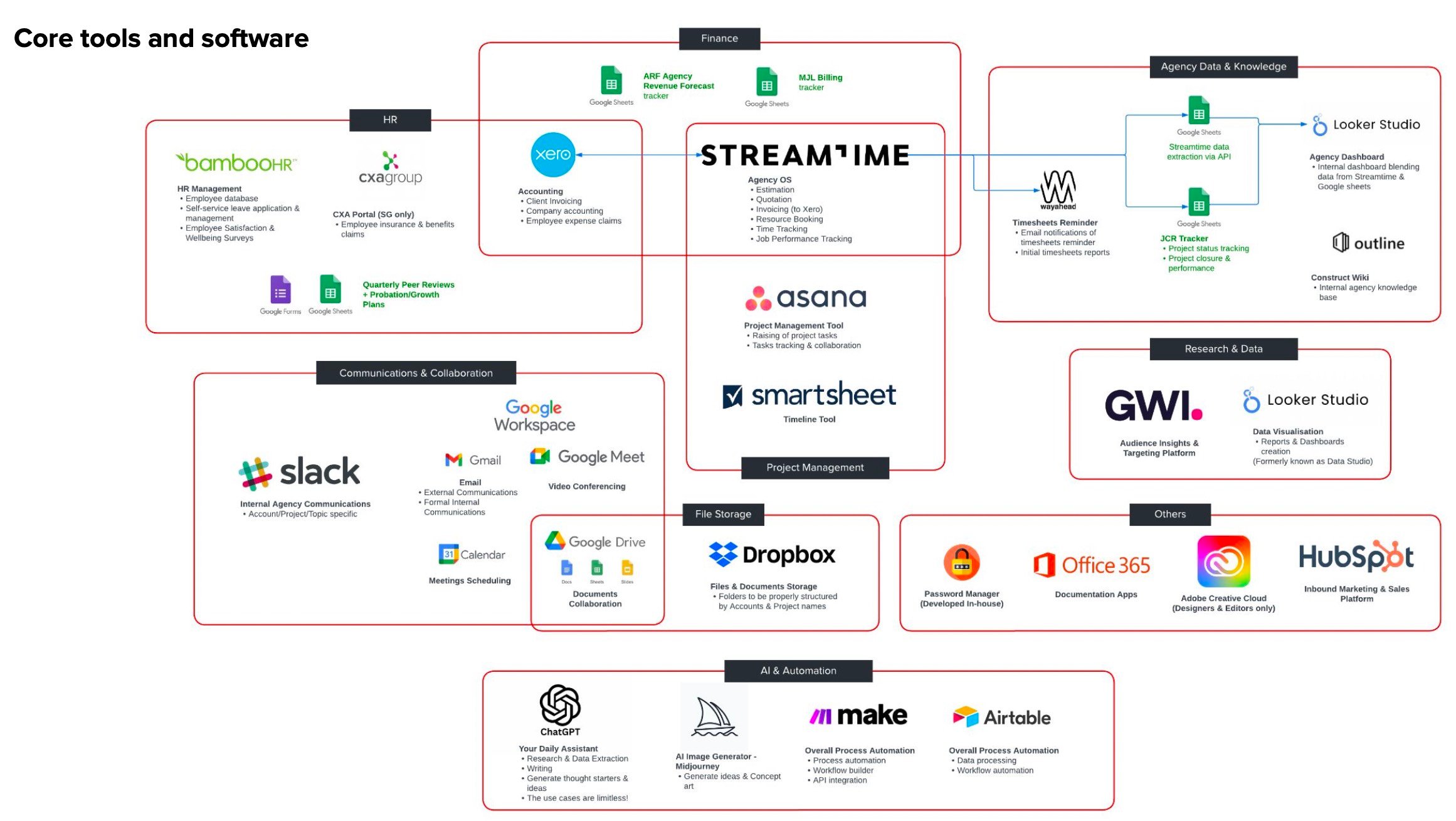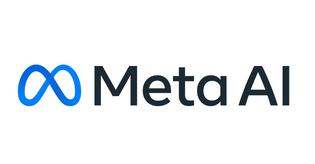This past month has been a testament to the relentless pace of AI growth, with major players like OpenAI, Google, and Meta unveiling game-changing advancements.
Construct’s POV
At Construct, we've always been at the forefront of embracing potent tools, investing early and substantially. Our approach has been to leverage these innovations to elevate our business operations. The Chart below is a schematic of some of the SaaS tools we have adopted across our agency as part of our own Transformation Strategy. We will continue to invest in technology to empower our people to deliver the best for our clients.

OpenAI's Power Moves
In the ever-evolving landscape of AI, OpenAI's forward leaps stand out prominently. Their recent introductions of ChatGPT Enterprise and the fine-tuning capabilities for GPT-3.5 Turbo underscore a strong commitment to reshaping business and marketing strategies.
ChatGPT Enterprise:
Within months of its launch, ChatGPT has become indispensable for over 80% of Fortune 500 companies. The enterprise variant is a testament to OpenAI's vision of providing businesses with robust, secure AI tools, tailored to drive marketing campaigns and enhance consumer engagement. With features such as unparalleled data security, SOC 2 compliance, and the prowess of GPT-4, it's primed to redefine AI's role in business strategies.
Fine-tuning GPT-3.5 Turbo:
The fine-tuning capability is a game-changer for marketers looking for AI personalization. It allows for model refinement to cater to specific tasks, ensuring AI becomes a tool that can echo a brand's voice, enhance content strategies, and deliver precise marketing messages.
Here’s how Marketers can think leveraging this capability to tailor AI to their unique needs:
Brand Voice Consistency: Train the AI to mirror a brand's unique tone, ensuring uniformity in all communications.
Improved Campaign Efficiency: Optimise models for specific marketing tasks, enhancing campaign targeting and alignment.
Customer Interaction: Fine-tune AI tools for on-brand customer interactions, elevating the user experience.
Reduced Overheads: Embed instructions directly, leading to faster API calls and cost savings.
Adaptability to Market Changes: Swiftly tweak AI tools in response to evolving market conditions or strategy shifts.
With fine-tuning, AI becomes not just a tool, but a strategic ally, evolving in tandem with a brand's journey.
Google's AI Arsenal: Democratising AI Access
Google's recent CloudNext 2023 event showcased its steadfast dedication to empowering businesses with the transformative capabilities of AI. Two significant innovations stood out, each promising to democratise access to AI in the workforce.
Duet AI's Evolution
One of the most anticipated announcements was the expansion of Duet AI. Initially introduced at Google I/O, this AI-powered collaboration tool is designed to enhance contextual code completion. Its latest iteration promises not only to help users modernise applications through code refactoring but also boasts productivity of workers by giving them access to a business context-aware personal assistant to attend calls with, take minutes during the call, call out action items, draft emails, and much more. While this tool offers immense potential, its pricing ($30/user/month) could be a point of contention. For small businesses, the lack of a sophisticated understanding of the balance between recognising the potential of such tools and managing software costs will be crucial.
Vertex AI & Gen App Builder: A New Dawn
Google's Vertex AI underwent a remarkable transformation, emerging as a shining light for businesses and developers seeking to unlock the full potential of AI. Alongside Vertex, the introduction of the Gen App Builder promises to reshape how businesses approach AI application development.
However, the real question remains: Are businesses ready to embrace these innovations? While Duet AI is already available in Singapore, its adoption by small businesses remains uncertain. Pricing can be a barrier, and the challenge lies in discerning whether the potential benefits outweigh the costs.
While Google's advancements are undeniably groundbreaking, their widespread adoption hinges on Businesses recognising their transformative potential. Want to discuss AI Strategy for your business? My team is here to help.
Meta's Grand Gesture: Open Source Shifts AI Power

The landscape of artificial intelligence has witnessed a seismic shift, which is being fuelled by the power of open source. And Meta's contributions on this front cannot be understated. Led by Yann LeCun, Meta's AI Chief, their continued commitment to releasing their AI research and Large Language Models to the open source communities has played a big part in disrupting the nascent battle for AI dominance. Meta's Open Source stance is testament to this, as it storms the stage, challenging the AI giants and redefining what's possible.
The Falcon Soars:
The Falcon 180B isn't just another large language model (LLM); it's a behemoth. Developed by The Technology Innovation Institute (TII) in the United Arab Emirates (UAE), it is the newer sibling to the original Falcom LLM, which has topped the Hugging Face LLM charts since it launch earlier this year. Falcon 180B was originally based on the "accidentally open-sourced" LLAMA model by Meta, and has over time been nurtured by the open-source community leading us to this point. With a staggering 180 billion parameters, Falcon 180B is trained on an unprecedented 3.5 trillion tokens. This scale places it a league ahead of Meta's LLaMA 2, which, until recently, was the crown jewel of open-source LLMs with its 70 billion parameters trained on 2 trillion tokens. The Falcon 180B's prowess isn't just in its size; its benchmark performance in natural language processing (NLP) tasks sets it apart, rivalling, and in some cases surpassing, commercial models like Google's PaLM-2.
Disrupting the AI Hegemony:
The emergence of Falcon 180B is more than just the unveiling of a powerful model; it signifies a broader trend. The AI community is pushing the boundaries, and open-source models are at the forefront of this revolution. The idea that an open-source model can go toe-to-toe with industry giants' offerings is not just surprising; it's groundbreaking. Falcon 180B's performance, almost on par with Google's PaLM-2 Large and positioned between OpenAI's GPT 3.5 and GPT4, is a clear indication of this shift.
The Implications:
But what does this mean for the AI world? The rise of powerful open-source models like Falcon 180B democratises AI, making it more accessible to researchers, developers, and businesses. It also signals a potential shift in the AI arms race. With the rapid advancements in LLMs, driven by innovations like LoRAs, weight randomisation, and Nvidia’s Perfusion, the playing field is levelling. The monopoly of AI giants is being challenged, and the power dynamics are evolving.
The Future is Open:
The release of Falcon 180B on Hugging Face opens up a realm of possibilities. As the AI community dives in, further enhancements and refinements are expected. But its immediate prowess in natural language capabilities sets a precedent. Open-source AI is no longer the underdog; it's a formidable contender.
My prediction: The future will not be ruled by One giant AI controlled by Google or OpenAI or X.ai, but it will blossom with millions of AIs each with open APIs that come together to extend human capability and capacity. As the winds of open source continue to gain momentum, they're reshaping the AI landscape. The balance of power is shifting, and the future looks more open, collaborative, and inclusive.
The Underdogs Making Waves: How Open Source Fuels Innovation
The recent release of Falcon 180B by Meta showcased the undeniable might of open source platforms. These platforms are not just levelling the playing field but also enabling smaller players to harness AI's potential and create innovative tools that are redefining the market.
1) Midjourney's Masterstroke Against Adobe
Midjourney's AI imagery tool is turning heads, offering an infill feature, "vary (region)", that promises to give Adobe Photoshop's Generative Fill a run for its money. This feature allows users to add or modify elements within images seamlessly, making the whole process intuitive and efficient. While Photoshop has been a stalwart in the image editing industry, Midjourney's competitive pricing, at just $10 a month, positions it as an appealing alternative for those on a budget. However, it's essential to note that Midjourney's tool currently works only on its platform-generated images. Despite this limitation, the rapid evolution of AI design tools signals a vibrant future for generative design.
2) Ideogram.ai: Merging Text with Imagery
The challenge of embedding coherent text within generated images has often been a stumbling block for many AI tools. But it seems Ideogram.ai has crack this one wide open. This image generation tool efficiently combines visuals with meaningful text, presenting a significant step forward in AI-powered image generation. In my tests, It performed well , with at least 1 to 3 of the provided options showing legible text. Its currently available for free, Ideogram.ai is a testament to how smaller players are leveraging open-source advancements to offer unique solutions.
3) RUNWAY ML: Redefining Generative Video
We've touched upon RUNWAY ML in past discussions, but their relentless innovation keeps bringing them back into the spotlight. Their recent feature allows users to exert control over camera movements in AI-generated videos. This capability, combined with the earlier introduced "motion slider", offers users unprecedented control over video generation. With features like selective zoom and direction adjustment, RUNWAY ML is ensuring that generative video becomes more user-centric and adaptable.
In the AI landscape, while giants like Google and Meta are make groundbreaking strides, it's these smaller entities like Midjourney, Ideogram.ai, and RUNWAY ML that are pushing boundaries, often leveraging the same open-source platforms. Their innovations highlight the democratising power of open source, ensuring that the future of AI will be rich, diverse, and full of surprises.

Race Analysis: The Open Source Revolution in the AI Landscape
The world of AI is shifting as open-source platforms democratise the field. Giants like OpenAI, Google, and Meta have been leading the way, but Meta's open-source strategy is the game-changer. By open-sourcing their research and models, Meta has empowered smaller players to compete with industry giants. Looking ahead, the AI landscape will be collaborative, with more options for businesses, innovative tools, and a focus on ethical AI use. The future of AI is a diverse and accessible landscape driven by both big players and underdogs, working together for the benefit of all.